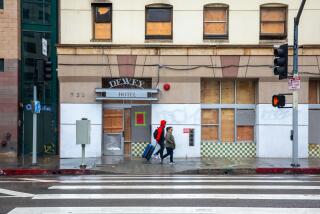A Housing Works dynamo smooths out the bumpy road for homeless
It’s a short ride from L.A.’s skid row to Hollywood, but throw in a detour and a few bumps and the journey can take six months, as it did for my friend Nathaniel Ayers.
The Juilliard-trained musician had been ensconced in the same downtown apartment for seven years, but things weren’t working out, and it was time to move on.
That was his landlord’s opinion and mine, too.
But Mr. Ayers insisted he was staying put, end of discussion. His apartment was his sanctuary, and few people were allowed into his space for inspections or anything else. That was part of the problem. And Mr. Ayers resented the very idea that he might be kicked out for writing on the walls. He once told me he had no choice — if he didn’t empty the clutter in his mind and keep it organized on the walls around him, he said, his head would explode.
I tried for months to help broker a solution. Yet after many conversations with the good folks at Lamp Community, which had helped rescue him from the streets, and Volunteers of America, which ran the apartment building, we had no answers. Mr. Ayers, whose career path was swamped 40 years ago by schizophrenia, was looking at the prospect of being evicted and becoming homeless again. I thought he’d do better in a part of town less intense than skid row.
And so I called Mollie Lowery.
Lowery would cringe at my saying so, but she has saved so many souls, there should be a statue of her on skid row. Reared in the San Fernando Valley, she served briefly as a nun, later worked in Santa Monica’s homeless community, and then joined philanthropist Frank Rice in 1985 to establish Lamp for chronically homeless people with severe mental illness.
Former L.A. Mayor Tom Bradley once said of her:
“Her low-key approach sort of catches you off guard. But before you know it, she’s like a whirling dervish, getting things done, and you don’t know how it happened.”
If the mayhem of skid row social work was Lowery’s love, serenity was her mistress, and she left Lamp in 2005 to start a retreat in the Eastern Sierra. Her clients came from skid row, trading sun-blasted asphalt for mountain ranges, where Lowery had them shearing llamas, riding horses and backpacking into the clouds on snowy slopes.
It was heaven, “but financially, I couldn’t keep it afloat,” said Lowery. She moved back to Los Angeles and eventually became program director of a Hollywood nonprofit called Housing Works, which provides housing and support to 320 individuals and families.
I was relieved when Lowery said yes, she’d try to help Mr. Ayers. But she knew it would be a tough case.
The first encounter did not go well. When I introduced Lowery to Mr. Ayers, he greeted her politely but informed her he would not vacate his apartment without a fight.
But Housing Works, established by members of the Immaculate Heart Community, stands behind a vow to do “whatever it takes for as long as it takes.” Lowery assigned Anthony Ruffin to begin meeting regularly with Mr. Ayers, and although he made headway in earning his trust, moving out remained a non-starter. The day Mr. Ayers had to clear out, we were all geared for a confrontation but got a surprise instead.
Mr. Ayers got up early, packed his French horn, trumpet, viola, violin, cello, string bass and keyboards and was ready to go.
Next stop was a MacArthur Park hotel, a temporary arrangement while Lowery began the hard work of lining up a psychiatric evaluation, applying for disability benefits and a housing voucher and calling everyone she’d ever worked with to see if there was an apartment out there, somewhere, even as resources were drying up because of federal sequestration.
“He needed someone to make the system … do what it’s meant to do,” said Lowery, who gets worked up over this topic. The people in greatest need of help are often least likely to get it, she said, and end up homeless or in jails and prisons.
But locked doors open for Lowery, who seems to know all the combinations. Her currency is hard-earned credibility, and she was able to get a voucher for Mr. Ayers, partly because everyone knows she stands with her clients through good times and bad.
Housing Works, by the way, doesn’t stockpile its clients in buildings designated for those with a mental illness. It places them among so-called regular people, in pleasant surroundings, as members of a larger community than the one they’ve been imprisoned in.
There was a last-minute snag last week. Mr. Ayers insisted he wasn’t moving out of the hotel, even after Lowery had finally lined up an apartment. Then out of the blue he called Lowery in gratitude, and she drove him to the Housing Authority for his final clearance.
On Thursday morning — after six months of hard work by Lowery, Ruffin and their colleagues Somatra Sean and Santiago Reyes — Mr. Ayers moved into a lovely apartment run by the Hollywood Community Housing Corp.
There will be bumps ahead. That’s just the way it is. But Mr. Ayers plopped onto his sofa to rest, then got up and stood on his balcony. A fresh breeze was blowing, and children could be heard playing at a nearby school.
“This is very great, very beautiful,” he said. “Mollie is absolutely incredible. She’s a real dream.”
More to Read
Start your day right
Sign up for Essential California for news, features and recommendations from the L.A. Times and beyond in your inbox six days a week.
You may occasionally receive promotional content from the Los Angeles Times.







